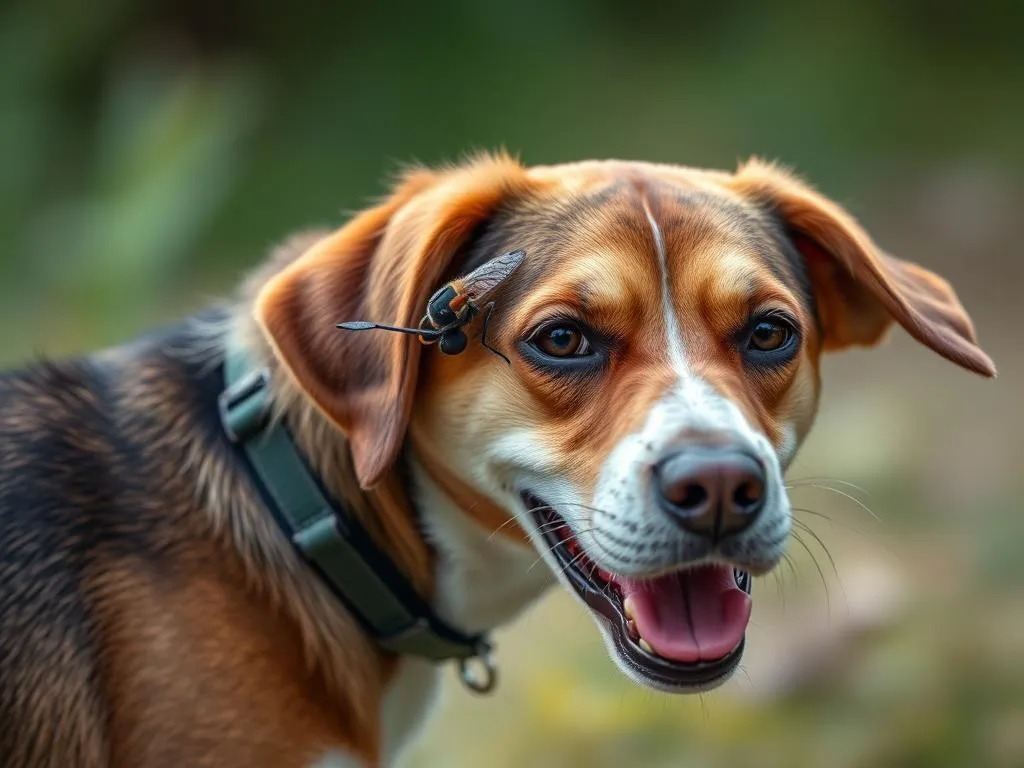
Understanding the Risks of Flies for Dogs
Health Risks Associated with Flies
Flies are not just a nuisance; they pose significant health risks to our furry friends. These pests can carry various diseases, including bacterial infections and maggot infestations. Flies can lay eggs on dog wounds or in their feces, leading to maggot infestations that can cause severe discomfort and health issues. Symptoms to watch for include excessive scratching, swelling around wounds, and signs of infection such as discharge or a bad odor.
In addition to direct infestations, flies can also transmit pathogens that cause gastrointestinal diseases. For instance, if a fly lands on contaminated food or surfaces and then comes into contact with your dog, it can lead to vomiting, diarrhea, and other gastrointestinal symptoms.
Why Fly Control is Essential
The impact of flies on a dog’s overall health cannot be overstated. Not only can they cause immediate discomfort, but they can also lead to long-term health problems. Flies are known carriers of various parasites, including fleas and ticks, which can further complicate your dog’s health. Effective fly control is crucial in preventing these additional problems, ensuring that your dog remains healthy and happy.
Types of Fly Repellents for Dogs
Chemical Fly Repellents
Chemical fly repellents are often the first choice for pet owners looking to protect their dogs from flies. Common ingredients found in these products include permethrin and DEET, which are effective in repelling flies and other pests.
Pros and Cons of Chemical Products:
– Pros: Fast-acting and highly effective, they provide immediate relief from flies and can cover a large area.
– Cons: Some dogs may have sensitivities to chemical ingredients, leading to skin irritations or allergic reactions. It’s essential to read labels carefully and choose products specifically designed for pets.
Safety Precautions: Always follow the manufacturer’s instructions when using chemical repellents. Avoid applying them near the dog’s eyes, nose, or mouth, and ensure the dog does not lick the treated area.
Natural Fly Repellents
For those seeking a more holistic approach, natural fly repellents can be an excellent alternative. Ingredients such as essential oils (like citronella, eucalyptus, and lavender) and certain herbs (like rosemary and mint) are known for their fly-repelling properties.
Benefits of Natural Solutions:
– They are generally safer for dogs and less likely to cause adverse reactions.
– Natural repellents often have additional benefits, such as soothing skin irritations or providing a pleasant scent.
DIY Recipes for Homemade Fly Repellents:
1. Essential Oil-Based Repellent: Mix 5 drops of eucalyptus oil with 2 cups of water in a spray bottle. Shake well before use.
2. Vinegar and Herb Solution: Combine equal parts vinegar and water with a handful of fresh herbs like rosemary. Let it steep for 24 hours before straining and using.
3. Citrus-Based Spray: Blend the peels of 2 lemons with 2 cups of water. Strain and pour into a spray bottle for an effective repellent.
Comparison of Fly Repellent Types
When considering the effectiveness of fly repellents for dogs, it’s essential to weigh chemical against natural options. Chemical repellents tend to work faster and may offer longer-lasting protection. However, natural repellents, while sometimes requiring more frequent application, are gentler on the dog’s skin and overall health.
Long-term use considerations also come into play; natural repellents may be more suitable for regular use, while chemical options might be reserved for particularly heavy infestations.
Top Recommended Fly Repellents for Dogs
Commercial Fly Repellent Products
When it comes to the best fly repellents for dogs, several commercial products stand out due to their effectiveness and user satisfaction:
| Product Name | Key Ingredients | Effectiveness | Price Range | User Reviews and Ratings |
|---|---|---|---|---|
| Vet’s Best Flea + Tick Spray | Peppermint oil, clove extract | Highly effective | $10 – $15 | 4.5/5 – Great for sensitive skin |
| Wondercide Natural Flea & Tick Spray | Cedarwood oil, peppermint oil | Effective and safe | $15 – $25 | 4.7/5 – Pleasant scent, easy to use |
| Adams Plus Flea & Tick Spray | Permethrin, pyrethrins | Fast-acting | $10 – $20 | 4.0/5 – Good for severe infestations |
| Natural Dog Company Flea & Tick Spray | Essential oils, coconut oil | Gentle yet effective | $20 – $30 | 4.8/5 – Great for regular use |
Homemade Fly Repellent Recipes
Creating your fly repellents at home can be a fun and effective way to protect your dog. Here are some detailed recipes:
- Essential Oil-Based Repellent:
- Ingredients: 5 drops of eucalyptus oil, 2 cups of water, 1 tablespoon of witch hazel.
-
Instructions: Combine all ingredients in a spray bottle. Shake well before each use. Spray directly on your dog’s coat, avoiding the face.
-
Vinegar and Herb Solution:
- Ingredients: 1 cup of apple cider vinegar, 1 cup of water, a handful of fresh rosemary.
-
Instructions: Combine ingredients in a jar and let sit for 24 hours. Strain before using. Apply to your dog’s coat as needed.
-
Citrus-Based Spray:
- Ingredients: Peels from 2 lemons, 2 cups of water.
- Instructions: Boil the lemon peels in water for 10 minutes, then strain. Let cool before transferring to a spray bottle. Apply to your dog’s coat.
Tips for Application and Storage of Homemade Repellents:
– Store homemade repellents in a cool, dark place and use them within a week for maximum effectiveness.
– Always do a patch test on a small area of your dog’s skin to ensure there are no adverse reactions.
Application and Usage Tips
How to Apply Fly Repellents
Applying fly repellents correctly is crucial for effectiveness. Here’s a step-by-step guide:
- Read Instructions: Whether using a commercial product or a homemade solution, always read the instructions carefully.
- Prepare Your Dog: Make sure your dog is calm. If they’re anxious, consider applying repellent after a walk or play session.
- Apply Evenly: Spray the repellent evenly over your dog’s coat, avoiding the face, especially the eyes, nose, and mouth.
- Massage In: Gently massage the product into the fur to ensure even distribution.
- Frequency of Application: Depending on the product, reapply as needed. For most sprays, reapplication every few hours is recommended, especially after your dog has been outdoors.
Additional Protective Measures
Keeping your dog safe from flies involves more than just applying repellents. Here are some additional protective measures:
- Keep the Environment Clean: Regularly clean your yard and home, removing any waste or food scraps that attract flies.
- Grooming Tips: Regular grooming helps keep your dog’s coat healthy and reduces the likelihood of flies being attracted to their fur.
Monitoring for Effectiveness
After applying fly repellents, monitor your dog for signs that the product is working. If your dog appears less bothered by flies and shows no signs of irritation, the repellent is likely effective. However, if you notice persistent fly activity or signs of discomfort, it may be time to try a different product or consult with your veterinarian.
Frequently Asked Questions (FAQs)
Are fly repellents safe for puppies?
Most fly repellents are safe for puppies, but it’s essential to choose products specifically formulated for younger dogs. Always consult your veterinarian before using any new product on a puppy.
How do I know if a repellent is effective?
An effective repellent will significantly reduce the number of flies bothering your dog. You should also notice fewer signs of irritation or discomfort.
Can I use human fly repellents on dogs?
No, human fly repellents often contain ingredients that can be toxic to dogs. Always use products specifically designed for pets.
What should I do if my dog has an adverse reaction to a repellent?
If you notice any signs of irritation, such as excessive scratching, redness, or swelling, wash the affected area with mild soap and water. If symptoms persist, contact your veterinarian immediately.
Conclusion
Using fly repellents for dogs is an essential aspect of pet care that can significantly enhance your dog’s health and comfort. By understanding the risks associated with flies and the various options available, you can make an informed choice tailored to your dog’s specific needs. Remember to consult with your veterinarian for personalized recommendations and to ensure you’re using the safest and most effective products for your furry friend.









